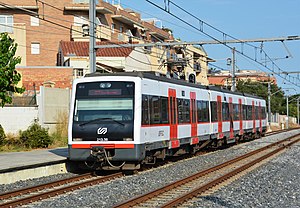FGC 213 Series
You can help expand this article with text translated from the corresponding article in Catalan. (May 2024) Click [show] for important translation instructions.
|
| 213 series | |
|---|---|
 A 213 EMU in Olesa de Montserrat | |
| Manufacturer | CAF, Alstom and Bombardier |
| Replaced | FGC 211 Series |
| Constructed | 1998–2008 |
| Entered service | 1 February 1999 |
| Number built | 126 vehicles (42 sets) |
| Formation | 3 cars per unit |
| Operators | Ferrocarrils de la Generalitat de Catalunya |
| Depots | Martorell-Enllaç |
| Lines served | Llobregat-Anoia line |
| Specifications | |
| Train length | 51.98 m (170 ft 6 in) |
| Car length |
|
| Width | 2.75 m (9 ft 0 in) |
| Height | 3.97 m (13 ft 0 in) |
| Doors |
|
| Maximum speed | 90 km/h (55 mph) |
| Weight | 97,2 t (full trainset) |
| Traction motors | 8 x ABB 4 EBA 35420 3-phase AC induction motor |
| Power output | 1.440 kW |
| Acceleration | 1.05 m/s² |
| Deceleration | 0.70 m/s² |
| Electric system(s) | 1,500 V DC overhead catenary |
| Current collector(s) | Pantograph |
| Safety system(s) | FAP |
| Track gauge | 1,000 mm (3 ft 3+3⁄8 in) |
The 213 series is a DC electric multiple unit (EMU) commuter and suburban train type operated by Ferrocarrils de la Generalitat de Catalunya, providing all passenger service on the Llobregat-Anoia line since 2009. First introduced in 1999, the trains operate as single units or coupled as 6 car double units.
Background
[edit]At the time of introduction in 1999, the 213 series initially replaced the more obsolete units that were still operating in the Llobregat-Anoia line (3000, 5000 and 8000 series). The new units provided passenger service next to the older 211 series.[1]
The trains were acquired in the context of modernization of the Llobregat-Anoia line and electrification of the Igualada branch. The first order of trains consisted of 20 units. The units were built by Alstom, CAF and Bombardier. They share many design elements with their standard-gauge counterpart in the Barcelona-Vallès line, the 112 series.[2]
Design
[edit]
The EMUs are 3 car units with 2 motor cars (one on each end) and a trailer car (the middle car). There are 2 doors per side on motor cars and 3 doors per side in the middle car. The central door on the middle car is lower than the rest, to provide at-grade PRM access. The rest of the doors include a folding step to allow access on the low platforms of the Llobregat-Anoia line. Every 213 unit includes a WC in car 2, next to the driver cab.[3]
Operations
[edit]
While most service is provided by single units, 213 units are commonly coupled to cope with demand in peak times. In 2015, the whole 42 units underwent a renovation project, which included upgrades of the interior lighting, seating, the WC and an update to the exterior livery.[4] The front livery was changed from orange to black.[5]
Fleet details
[edit]Currently, there are 42 units in service, providing all passenger service in the Llobregat-Anoia line.
Named units
[edit]Several units have been given names, either after towns served by the line or notable Catalan writers.[3]
- 213.01 - Igualada
- 213.02 - Manresa
- 213.03 - Capellades
- 213.04 - Piera
- 213.05 - Sant Andreu de la Barca
- 213.06 - Castellbell i el Vilar
- 213.07 - Vilanova del Camí
- 213.08 - Sant Vicenç dels Horts
- 213.09 - Sant Vicenç de Castellet
- 213.10 - Vallbona d'Anoia
- 213.11 - Martorell
- 213.12 - Pallejà
- 213.13 - Sant Esteve Sesrovires
- 213.14 - Sant Boi de Llobregat
- 213.15 - Santa Coloma de Cervelló
- 213.16 - Masquefa
- 213.17 - Olesa de Montserrat
- 213.18 - Abrera
- 213.19 - La Pobla de Claramunt
- 213.20 - Monistrol de Montserrat
- 213.22 - Josep Carner
- 213.23 - Joan Perucho
- 213.25 - Joanot Martorell
- 213.26 - Enric Prat de la Riba
- 213.28 - Dolors Monserdà
- 213.31 - Joan Cererols
- 213.33 - Joan Brossa
- 213.35 - Rosa Sensat
References
[edit]- ^ Carril. Associació d'Amics del Ferrocarril de Barcelona [Barcelona], número 65, 2007. ISSN: 1136-2499
- ^ Carril. Associació d'Amics del Ferrocarril de Barcelona [Barcelona], número 65, 2007. ISSN: 1136-2499
- ^ a b "Unitats sèrie 213". Trenscat. Retrieved 2023-11-03.
- ^ "FGC renueva los trenes de la linea Llobregat-Anoia". La Vanguardia. 17 July 2015. Retrieved 2023-11-03.
- ^ "Renovació dels trens de la línia Llobregat-Anoia d'FGC". Trenpassió. Retrieved 2023-11-03.
This article needs additional or more specific categories. (November 2023) |
